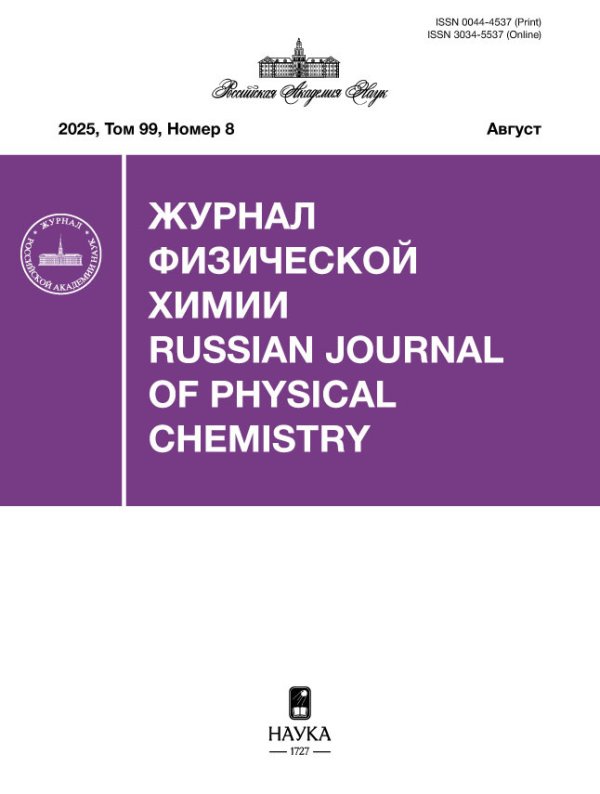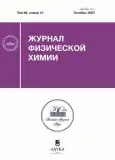ЭИС-исследование оксидного слоя в пористом тантале
- Authors: Сюгаев А.В.1, Еремина М.А.1
-
Affiliations:
- Удмуртский федеральный исследовательский центр УрО РАН
- Issue: Vol 98, No 10 (2024)
- Pages: 141–149
- Section: ELECTROCHEMISTRY. GENERATION AND STORAGE OF ENERGY FROM RENEWABLE SOURCES
- Submitted: 29.05.2025
- Published: 11.10.2024
- URL: https://innoscience.ru/0044-4537/article/view/681111
- DOI: https://doi.org/10.31857/S0044453724100203
- EDN: https://elibrary.ru/DZQVGS
- ID: 681111
Cite item
Abstract
Электрохимической импедансной спектроскопией изучено влияние потенциала (E) на емкость (С) пористого тантала, покрытого слоем аморфного Ta2O5. Показано, что в широком диапазоне потенциалов наблюдается положительная линейная зависимость 1/С2 от потенциала, значение коэффициента наклона которой может использоваться для контроля оксидного слоя в пористом тантале. Установлено, что трансформация оксидного слоя при отжигах в диапазоне температур 100–700°С существенно влияет на 1/С2(E)-графики. Отжиги при температурах 100–500°С увеличивают концентрацию кислородных вакансий в оксидном слое из-за перехода части кислорода в тантал, что приводит к появлению участков с меньшим коэффициентом наклона по сравнению с исходным образцом. После отжигов при температурах 600 и 700°С в оксидной пленке формируется фаза TaO, что сопровождается значительным возрастанием емкости и ее слабой зависимостью от потенциала из-за появления в оксидной пленке высокой концентрации доноров. Показана перспективность использования 1/С2(E)-зависимостей для контроля оксидного слоя в пористом тантале, что может быть полезно для технологии танталовых конденсаторов.
Full Text
About the authors
А. В. Сюгаев
Удмуртский федеральный исследовательский центр УрО РАН
Author for correspondence.
Email: syual@udman.ru
Russian Federation, Ижевск
М. А. Еремина
Удмуртский федеральный исследовательский центр УрО РАН
Email: syual@udman.ru
Russian Federation, Ижевск
References
- Song H.-K., Jung Y.-H., Lee K.-H., Dao L.H. // Electrochim. Acta. 1999. V. 44. P. 3513. https://doi.org/10.1016/S0013-4686(99)00121-8
- Song H.-K., Hwang H.-Y., Lee K.-H., Dao L.H. // Electrochim. Acta. 2000. V. 45. P. 2241. https://doi.org/10.1016/S0013-4686(99)00436-3
- Abouelamaiem D.I., He G., Neville T.P. et al. // Electrochim. Acta. 2018. V. 284. P. 597. https://doi.org/10.1016/j.electacta.2018.07.190
- Syugaev A.V., Zonov R.G., Mikheev K.G. et al. // J. Phys. Chem. Solids. 2023. V. 181. № 111533. https://doi.org/10.1016/j.jpcs.2023.111533
- Huang J., Gao Y., Luo J. et al. // J. Electrochem. Soc. 2020. V. 167. № 166503. https://doi.org/10.1149/1945-7111/abc655
- Сюгаев А.В., Порсев В.Е. // Конденсированные среды и межфазные границы. 2024. Т. 26. № 1. С. 135. https://doi.org/10.17308/kcmf.2024.26/11817 (Syugaev A.V., Porsev V.E. // Condensed Matter and Interphases. 2024, V. 26. № 1. P. 135. https://doi.org/10.17308/kcmf.2024.26/11817)
- Toor Ihsan-ul-Haq // J. Electrochem. Soc. 2011. V. 158. P. C391. https://doi.org/10.1149/2.083111jes
- Baka O., Bacha O., Redha Khelladi M., Azizi A. // Bull. Mater. Sci. 2023. V. 46. № 84. https://doi.org/10.1007/s12034-023-02915-5
- Mibus M., Jensen C., Hu X. et al. // Appl. Phys. Lett. 2014. V. 104. № 244103. http://doi.org/10.1063/1.4882656
- Daideche K., Azizi A. // J Mater Sci: Mater Electron. 2017. V. 28. P. 8051. http://doi.org/10.1007/s10854-017-6511-8
- Levine K.L., Tallman D.E., Bierwagen G.P. // J. Mater. Process. Tech. 2008. V. 199. P. 321. http://doi.org/10.1016/j.jmatprotec.2007.08.023
- Mardare A.I., Ludwig A., Savan A., Hassel A.W. // Sci. Technol. Adv. Mater. 2014. V. 15. № 015006. http://doi.org/10.1088/1468-6996/15/1/015006
- Shelekhov E.V., Sviridova T.A. // Met. Sci. Heat Treat. 2000. V. 42. P. 309. http://doi.org/10.1007/BF02471306
- Jang J.H., Yoon S., Ka B.H. et al. // J. Electrochem. Soc. 2005. V. 152. P. A1418. https://doi.org/10.1149/1.1931469
- Ge H., Tian H., Zhou Y. et al. // ACS Appl. Mater. Interfaces. 2014. V. 6. P. 2401. https://doi.org/10.1021/am404743a
- Hankin A., Bedoya-Lora F.E., Alexander J.C. et al. // J. Mater. Chem. A. 2019. V. 7. P. 26162. https://doi.org/10.1039/c9ta09569a
- Nguyen H.T., Tran T.L., Nguyen D.T. et al. // J. Korean Ceram. Soc. 2018. V. 55. P. 244. https://doi.org/10.4191/kcers.2018.55.3.11
- Ла Мантия Ф., Хабазаки X., Сантамария М., Ди Кварто Ф. // Электрохимия. 2010. Т. 46. С. 1395. (La Mantia F., Habazaki H., Santamaria M., Di Quarto F. // Russian J. Electrochem. 2010. V. 46. P. 1306. https://doi.org/10.1134/S102319351011011X)
- Di Quarto F., La Mantia F., Santamaria M. // Electrochim. Acta. 2005. V. 50. P. 5090. https://doi.org/10.1016/j.electacta.2005.03.065
- Deo M., Möllmann A., Haddad J. et al. // Nanomaterials. 2022. V. 12. № 780. https://doi.org/10.3390/nano12050780
- Chun W.-J., Ishikawa A., Fujisawa H. et al. // J. Phys. Chem. B. 2003. V. 107. P. 1798. https://doi.org/10.1021/jp027593f
- Freeman Y., Lessner P. // IMAPS High Temperature Electronics Network (HiTEN2019). P. 000091. https://doi.org/10.4071/2380-4491.2019.HiTen.000091
- Garg S.P., Krishnamurthy N., Awasthi A., Venkatraman M. // J. Phase Equilibria. 1996. V. 17. P. 63. https://doi.org/10.1007/BF02648373
- Korshunov A.V, Pustovalov A.V., Morozova T.P., Perevezentseva D.O. // Oxid. Met. 2020. V. 93. P. 301. https://doi.org/10.1007/s11085-020-09957-8
- Sethi G., Bontempo B., Furman E. et al. // J. Mater. Res. 2011. V. 26. P. 745. https://doi.org/10.1557/jmr.2010.77
- Guo Sheng Moo J., Awaludin Z., Okajima T., Ohsaka T. // J. Solid State Electrochem. 2013. V. 17. P. 3115. https://doi.org/10.1007/s10008-013-2216-y
Supplementary files
















